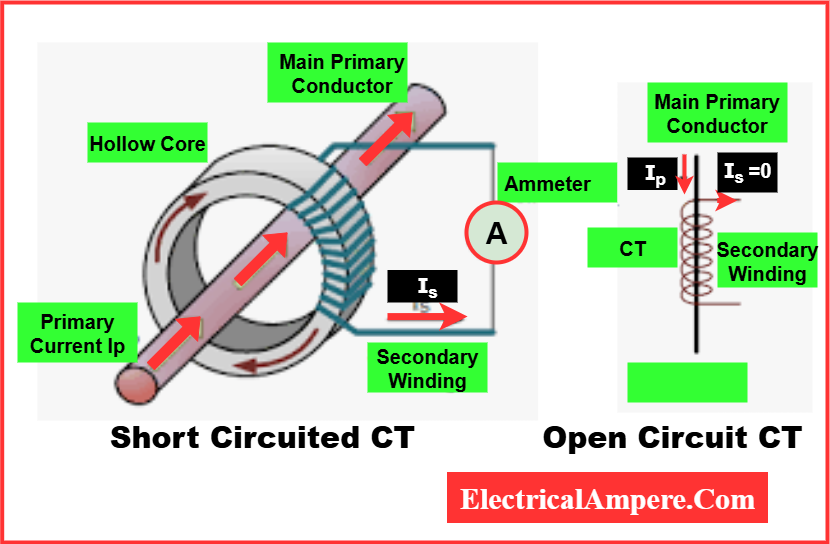The secondary of a Current Transformer (CT) should not be open because it can generate dangerously high voltage, leading to insulation failure, equipment damage, and serious electric shock hazards. That’s why the CT secondary is always short-circuited when not connected to instruments or relays.
In this article, we’ll break down why CT secondary should never be open, what happens if it is left open, and how it differs from PT (Potential Transformer) practice.
What is a Current Transformer (CT)?
A current transformer is an instrument transformer that steps down high current to a lower, measurable level.
- Primary winding → connected in series with the main circuit, carrying full load current.
- Secondary winding → connected to meters, relays, or other protective devices.
- Function → ensures safe current measurement and system protection without exposing instruments to dangerous current levels.
Why CT Secondary Should Never Be Open
Leaving the CT secondary open is unsafe and must be avoided. Here are the main reasons:
1. Dangerous High Voltage Across Secondary
- With an open secondary, the CT core gets over-excited.
- This induces very high voltage (sometimes several kV) across the open terminals. Depending on the CT design and core material, this voltage can rise from 2 kV to 5 kV, and in extreme cases, even reach tens of kilovolts.
- It can cause insulation breakdown and arcing.
2. Risk of Electric Shock
- The high induced voltage makes secondary terminals hazardous to touch.
- This exposes operators and technicians to severe shock danger.
3. Overheating and Core Damage
- Without a closed secondary path, the CT draws excessive magnetizing current.
- This overheats and permanently damages the CT winding and core.
4. Wrong Readings and Protection Failure
- Open secondary means no secondary current flows.
- Meters will show zero readings and protective relays will fail to operate.
- This can cause severe equipment damage in case of faults.
Why CT Secondary is Always Short Circuited
To avoid these risks, the CT secondary is always kept short-circuited when not in use.
- A short circuit provides a safe path for secondary current.
- Prevents dangerous high voltages.
- Maintains CT health and ensures safety.
- Special shorting terminals or switches are provided for this purpose.

How Closed CT Secondary Maintains Magnetic Balance
A Current Transformer (CT) works on the principle of mutual induction, just like a power transformer. But there’s one key difference:
- In a power transformer, the applied voltage controls the flux.
- In a CT, the primary current (coming from the main circuit) drives the flux, regardless of the secondary.
So, how does closing the CT secondary maintain magnetic balance?
1. Primary Current Creates Flux
- The primary winding (carrying load current) produces a magnetic flux in the CT core.
- This flux is proportional to the primary current (Ip).
2. Secondary Current Balances the Flux
- When the secondary is closed (short-circuited or connected to burden), current flows in the secondary winding.
- This secondary current (Is) produces an opposing flux in the core (as per Lenz’s Law).
- The opposing flux cancels most of the primary flux → leaving only a small flux to magnetize the core.
3. Magnetic Balance
- This opposition between primary flux and secondary flux keeps the core flux small and balanced.
- That’s why the CT operates linearly, giving accurate current transformation.
4. What If Secondary is Open?
- With the secondary open, no secondary current flows.
- The primary flux is unopposed, so the core saturates.
- Result → excessive flux, high induced voltage in secondary, danger of shock and insulation damage.
Key Point: A closed CT secondary provides a return path for current, which generates an opposing flux that balances the primary flux. This magnetic balance ensures safe operation, accuracy, and prevents dangerous high voltages.
Comparison: CT vs PT Secondary
| Transformer | Secondary Condition | Reason |
| Current Transformer (CT) | Always short-circuited | Prevents high voltage buildup and shock hazard |
| Potential Transformer (PT) | Always open-circuited | Supplies measuring instruments with safe voltage |
This shows why CT secondary should not be open, while PT secondary is open-circuited.
Current Transformer Working Principle (Quick Recap)
- Works on mutual induction principle.
- Secondary current ∝ Primary current ÷ Turns ratio.
- Unlike a power transformer, the CT’s primary current is fixed by the load circuit.
- Hence, secondary must always provide a safe path for current flow.
Key Takeaways
- CT secondary should never be open → it leads to high voltage, shock hazards, and CT damage.
- The safe practice is to keep CT secondary short-circuited when not connected to instruments.
- PT secondary is open, while CT secondary is short — opposite operating conditions.
- Following this rule ensures operator safety, accurate measurement, and reliable protection.
Related Articles: